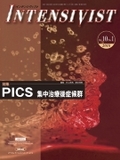Japanese
English
- 有料閲覧
- Abstract 文献概要
- 1ページ目 Look Inside
- 参考文献 Reference
重症患者における栄養療法の大切さが各ガイドラインで示されているが,長期予後を視点においた研究はまだ少ない。侵襲時には筋タンパクの異化が亢進し,筋肉量が減ることが知られている。本邦はさらなる超高齢社会を迎えるが,高齢者では筋肉量が減少し,虚弱状態,サルコペニア,フレイルなどを呈していることが多く,栄養障害との関連が注目されている。今後のICU入室には栄養障害のある高齢者が多くなると予想され,ICU入室時から“適切な栄養療法”が求められる。“適切な栄養療法”には,至適エネルギー量の決定や筋肉量,筋力の維持・増強のためのタンパク投与が注目されているものの,まだ明確なコンセンサスが得られていない。
Main points
●ICU入室時の栄養障害および骨格筋の減少,ICUにおけるエネルギー負債などが重症患者の予後不良因子であり,ICU-AWを含めたPICSの発症と関連している可能性がある。
●BMIではサルコペニアなどの診断ができず,骨格筋量の測定にはCTなどを用いた客観的な評価計測が必要である。
●至適エネルギー量の測定には間接熱量測定が最も妥当であると考えられるが,まだ問題点も指摘されている。
●早期経腸栄養と長期予後との関連は,大規模な臨床研究の結果からは一定の見解が得られておらず,また運動機能・認知機能・精神障害などのPICS関連因子への影響は十分検討されていない。
●高齢者のPICS対策として,タンパク投与を含む適切な栄養療法と早期リハビリテーションを組み合わせたほうが有用である可能性がある。
Although the importance of nutritional therapy has been emphasized in nutritional guidelines for critically ill patients, there are few studies investigating the effects of the nutritional therapy on long-term outcomes. Critical illness is associated with hypermetabolism and marked protein catabolism, and therefore muscle wasting is a frequent finding. Muscle loss and weakness including sarcopenia and frailty are associated with malnutrition. The incidence of sarcopenia and frailty in the elderly has been increasing towards the future. The number of critically-ill elderly patients with various degrees of malnutrition is also increasing, and therefore, optimal nutritional therapy needs to be initiated on admission to the intensive care unit. For malnourished patients, although there is no definitive consensus, optimal provision of energy and protein to maintain muscle mass to maintain function is a mainstay.

Copyright © 2018, MEDICAL SCIENCES INTERNATIONAL, LTD. All rights reserved.


